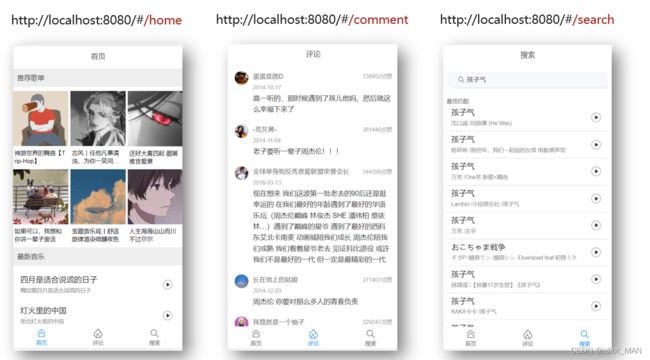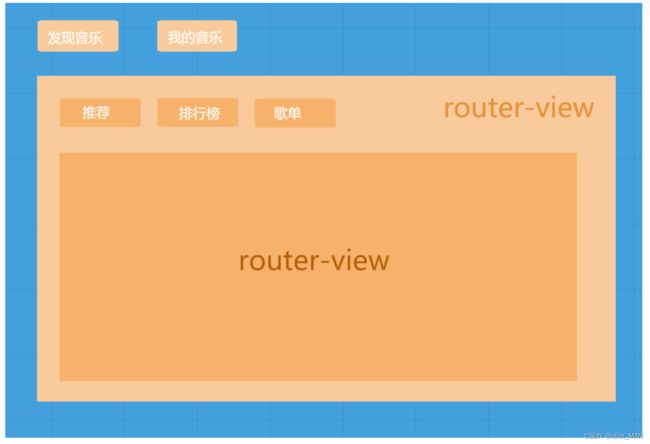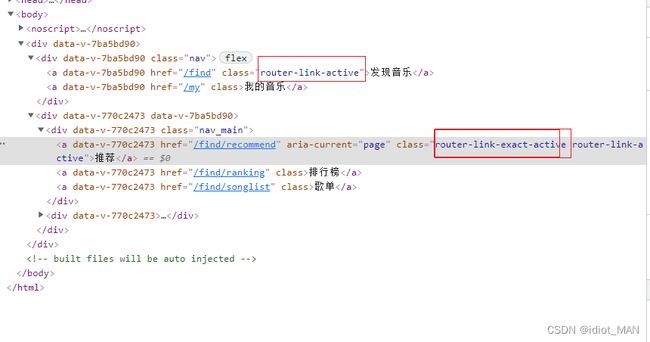vue路由---超级详细,通俗易懂(完整版)
vue路由—超级详细,通俗易懂
文章目录
- vue路由---超级详细,通俗易懂
-
-
- 生活中的路由
- 后端路由
- 前端路由
- 为什么使用路由
- vue-router介绍
- 路由-组件分类
- vue-router使用
-
-
- 安装
- 导入路由
- 关联到vue实例
- 路由出口
-
- 声明式导航
- 重定向
- 路由-404页面
- 路由模式设置
- vue路由-编程式导航
- 嵌套路由
-
-
-
-
- 配置路由规则
- App.vue写路由出口
- Find.vue写二级路由出口
-
-
-
- 声明式导航--类名区别
-
- 路由传参
-
-
- 声明式导航
- 编程式导航
-
- 路由守卫
-
-
-
- 全局前置守卫
-
-
- Vant组件库
-
-
-
- 安装
- 导入所有的组件
- 手动按需引入
- 自动按需引入组件
-
-
生活中的路由
设备和ip的映射关系
后端路由
接口和服务的映射关系
前端路由
路径和组件的映射关系
为什么使用路由
在一个页面里,切换业务场景
vue单页面应用(SPA):所有的功能在一个html页面上实现
优点:
- 整体不刷新页面,用户体验好
- 数据传递容易,开发效率高
缺点:
- 开发成本高(需要学习专门只是)
- 首次加载比较慢,不利于SEO
vue-router介绍
vue集成路由
https://router.vuejs.org/zh/
vue-router模块包,它和vue.js深度集成
定义映射规则-----模块化—提供2个内置全局组件
路由-组件分类
.vue文件分2类,一个页面组件,一个是复用组件
.vue文件本质无区别
src/views(pages)文件夹 —页面组件—配合路由使用
src/components文件夹 —复用组件(展示数据–复用)
总结:views下的页面组件,配合路由切换;components下的一般引入到views下的vue中复用展示数据
vue-router使用
安装
yarn add [email protected]
或者
npm i add [email protected]
导入路由
src下创建router/index.js
import Vue from 'vue'
// 1导入路由
import VueRouter from 'vue-router'
// 引入组件
// import Home from '../views/Home'
// import Login from '../views/Login'
// import Register from '../views/Register'
// 2 使用路由插件
// 在vue中 使用vue的插件 需要调用Vue.use()
Vue.use(VueRouter)
// 3 创建vue路由规则
const routes = [
// 路径和组件的映射关系
{
path: '/',
// component: Home,
// 路由懒加载
component: () => import('../views/Home'),
},
{
path: '/login',
component: () => import('../views/Login'),
},
{
path: '/register',
component: () => import('../views/Register'),
},
]
// 4创建路由对象 传入规则
const router = new VueRouter({
// routes: routes,
routes,
})
// 导出路由对象
export default router
关联到vue实例
import router from './router'
Vue.config.productionTip = false
new Vue({
router,
render: (h) => h(App),
}).$mount('#app')
// .$mount挂载到 id="app"的元素上 相当于el选项
路由出口
App.vue
声明式导航
使用全局组件 router-link来替代a标签
- vue-router提供了一个全局组件 router-link
- router-link 实质上最终会渲染成a链接,to属性等价于提供href属性(to无需#)
- router-link提供了声明式导航高亮的功能(自带类名)
重定向
强制切换到目标path上
- 网页打开url默认hash值是 / 路径
- redirect 是设置要重定向到那个路由路径
需求:网页默认打开, 匹配路由 ‘/’ 强制切换到 ‘/home’上
const routes = [
{
path: '/',
redirect: '/h ome', //重定向到 /home
},
}
总结: 强制重定向后,还会重新来数组中匹配一次规则
路由-404页面
如果路由hash值没有和数组里规则匹配
默认给一个404页面
路由最后,path匹配 *(任意路径) --前面都不匹配,就匹配最后这个,显示对应的组件
-
创建NotFound页面
404 -
修改路由配置
const routes = [ // 写在最后 // { // path: '*', // redirect: '/home', // }, { path: '*', component: () => import('../views/NotFound'), }, ]
**总结:**如果路由未命中任何规则,给出一个兜底的404页面
路由模式设置
修改路由在地址栏的模式
hash路由 : 地址栏URL中的#符号 http://localhost:3000/#/abc ,不会被包括在HTTP请求中,对后端完全没有影响,改变hash不会重新加载页面
history路由:http://localhost:3000/abc(需要服务器支持,否则找的是文件夹)
利用了HTML5 新增的pushState() 和replaceState()方法
// 4创建路由对象 传入规则
const router = new VueRouter({
// routes: routes,
routes,
mode: 'history', //默认是hash
})
vue路由-编程式导航
编程式导航:用js代码跳转
声明式导航:router-link实现跳转
语法:
this.$router.push({
path:"路由路径",
name:"路由名"
})
router/index.js 路由规则里,给路由起名字
const routes = [
// 路径和组件的映射关系
{
path: '/home',
name: 'home',
component: () => import('../views/Home'),
},
{
path: '/login',
name:"login",
component: () => import('../views/Login'),
},
{
path: '/register',
name:"register",
component: () => import('../views/Register'),
},
]
App.vue中router-link换成span,配合js的编程式导航跳转
编程式导航: js方式跳转路由
语法:
this. r o u t e r . p u s h ( p a t h : " 路由路径 " ) t h i s . router.push({path:"路由路径"}) this. router.push(path:"路由路径")this.router.push({name:“路由名”})
注意:
虽然用name跳转,但是url的hash值还是切换path路径值
场景
方便修改,name路由名(在页面上看不见,随便修改)
path可以在url的hash值看到(尽量符合组件内规范)
嵌套路由
在现有的一级路由下,再嵌套二级路由
- 创建需要用的所有组件
- src/views/Find.vue ----发现音乐
- src/views/My.vue—我的音乐
- src/views/Second/Recommend.vue —发现音乐/推荐页面
- src/views/Second/Ranking.vue —发现音乐/排行榜
- src/views/Second/SongList.vue —发现音乐/歌单页面
- main.js 配置2级路由
- 一级路由由path从/开始定义
- 二级路由往后path 直接写名字 ,无需 / 开头
- 二级路由在上级路由的children数组里编写路由信息对象
- 说明
- App.vue 的router-view 负责发现音乐 和我的音乐页面 切换
- Find.vue的router-view负责发现音乐下的三个页面切换
配置路由规则
const routes = [
{
path: '/',
redirect: '/find', //重定向到 /home
},
{
path: '/find',
redirect: '/find/recommend',
component: () => import('../views/Find'),
children: [
{
path: 'recommend',
component: () => import('../views/Second/Recommend'),
},
{
path: 'ranking',
component: () => import('../views/Second/Ranking'),
},
{
path: 'songlist',
component: () => import('../views/Second/SongList'),
},
],
},
{
path: '/my',
component: () => import('../views/My'),
},
{
path: '*',
component: () => import('../views/NotFound'),
},
]
App.vue写路由出口
App.vue 的router-view 负责发现音乐 和我的音乐页面 切换
Find.vue写二级路由出口
Find.vue的router-view负责发现音乐下的三个页面切换
**总结:**嵌套路由,找准在那个页面里写router-view和对应的规则里写children
声明式导航–类名区别
router-link 自带的2个类名的区别是什么
router-link-active(模糊匹配) url中hash值,包含href属性值这个路径
router-link-exact-active(精确匹配) url中hash值路径,与href属性值完全相同,设置此类名
路由传参
跳转路由时 可以给路由对应的组件内传参
声明式导航
router-link 上的to属性,语法格式
/path?参数名=值
/path/值 ------需要路由对象提前配置 path:'/path/:参数名'
对应的页面组件接收传递过来的值
$route.query.参数名
$route.params.参数名
router/index.js
// 3 创建vue路由规则
const routes = [
{
path: '/',
redirect: '/list', //重定向到 /home
},
{
path: '/list',
component: () => import('../views/List'),
},
{
path: '/part',
component: () => import('../views/Part'),
},
{
path: '/detail/:name',
component: () => import('../views/Detail'),
},
{
path: '*',
component: () => import('../views/NotFound'),
},
]
List.vue
朋友--小川
朋友--小妞
朋友--{{ n1 }}
朋友--{{ n1 }}
Part.vue
关注明星
{{ $route.query.name }}
{{ name }}
Detail.vue
detail
{{ $route.params.name }}
{{ name }}
编程式导航
语法:
query/params 任选一个
this.$router.push({
path:"路由路径",
name:"路由名",
query:{
"参数名":"值"
},
params:{
"参数名":"值"
}
})
List.vue
朋友--小川
朋友--小妞
朋友--{{ n1 }}
朋友--{{ n1 }}
朋友--小川
朋友--小妞
朋友--{{ n1 }}
朋友--{{ n1 }}
路由守卫
https://router.vuejs.org/zh/guide/advanced/navigation-guards.html
ue-router 提供的导航守卫主要用来通过跳转或取消的方式守卫导航。这里有很多方式植入路由导航中:全局的,单个路由独享的,或者组件级的。
全局前置守卫
需求:在跳转路由前,判断用户是否登录,登录了才能跳转到“我的音乐“页面,未登录弹窗提示
在路由对象上使用固定的方法 beforeEach
路由跳转"之前" 先执行这里,决定是否跳转
router.beforeEach((to,from ,next)=>{
to 要跳转到的路由 (路由对象信息) 目标
from 从哪里跳转的路由(路由对象信息) 来源
next 函数体, next() 才会让路由正常的跳转切换, next(false)在原地停留 next(“路由路径”) 强制修改到另一个路由路径上
不调用next 页面留在原地
})
// 1 在路由对象上使用固定的方法 beforeEach
/*
路由跳转"之前" 先执行这里,决定是否跳转
router.beforeEach((to,from ,next)=>{
to 要跳转到的路由 (路由对象信息) 目标
from 从哪里跳转的路由(路由对象信息) 来源
next 函数体, next() 才会让路由正常的跳转切换, next(false)在原地停留 next("路由路径") 强制修改到另一个路由路径上
不调用next 页面留在原地
})
*/
// 在跳转路由前,判断用户是否登录,登录了才能跳转到“part“页面,未登录弹窗提示
const isLogin = false //登陆状态 (未登陆)
router.beforeEach((to, from, next) => {
// console.log(to)
// console.log(from)
if (to.path === '/part' && isLogin === true) {
alert('请登陆')
next(false)
} else {
next() //正常放行
}
})
Vant组件库
https://vant-contrib.gitee.io/vant/v2/#/zh-CN/
vant 轻量、可靠的移动端 Vue 组件库
安装
yarn add vant@latest-v2 -S
导入所有的组件
main.js中导入
// 导入所有的组件
import Vant from 'vant'
import 'vant/lib/index.css'
Vue.use(Vant)
使用组件
主要按钮
信息按钮
默认按钮
警告按钮
危险按钮
手动按需引入
只引入使用的组件
在不使用插件的情况下,可以手动引入需要的组件。—每一个组件中引入
import Button from 'vant/lib/button';
import 'vant/lib/button/style';
注册 --使用
主要按钮
信息按钮
默认按钮
警告按钮
危险按钮
自动按需引入组件
babel-plugin-import 是一款 babel 插件,它会在编译过程中将 import 的写法自动转换为按需引入的方式。
安装插件
yarn add babel-plugin-import -D
babel.config.js配置,重新启动项目
module.exports = {
plugins: [
['import', {
libraryName: 'vant',
libraryDirectory: 'es',
style: true
}, 'vant']
]
};
组件中使用
主要按钮
信息按钮
默认按钮
警告按钮
危险按钮
babel-plugin-import 是一款 babel 插件,它会在编译过程中将 import 的写法自动转换为按需引入的方式。
安装插件
yarn add babel-plugin-import -D
babel.config.js配置,重新启动项目
module.exports = {
plugins: [
['import', {
libraryName: 'vant',
libraryDirectory: 'es',
style: true
}, 'vant']
]
};
组件中使用
主要按钮
信息按钮
默认按钮
警告按钮
危险按钮





